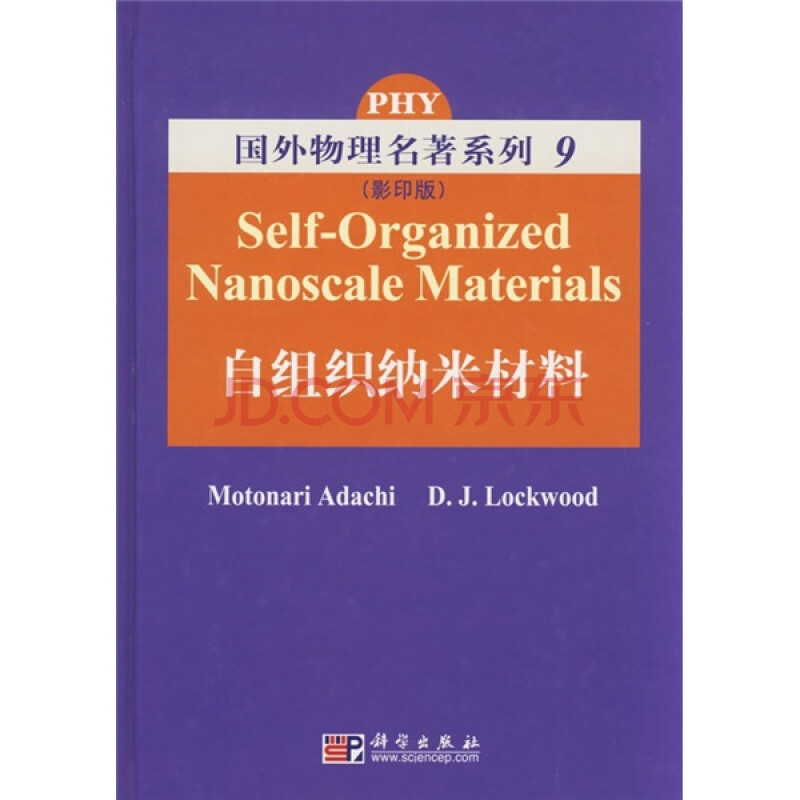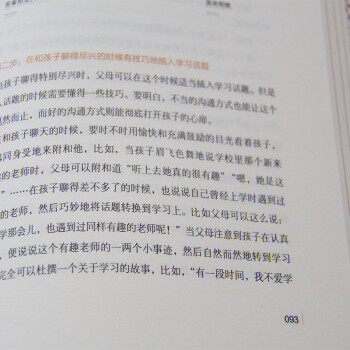热门推荐商品
-
神奇的逻辑思维游戏书 5-13岁提升孩子逻辑思维训练
¥22.50
-
正面管教 修订版 如何不惩罚不娇纵有效管教孩子 育儿百科 最温柔的教养 樊登 早教书
¥19.00
-
一本书读懂中国茶
¥24.90
-
中国国家地理:最好的时光在路上
¥24.90
-
正面管教儿童行为心理学
¥19.00
-
正面管教男孩100招(养育男孩全书)父母的语言话术
¥18.00
-
陪孩子度过7~9岁叛逆期(7-9岁关键养育 叛逆不是孩子的错 男孩女孩自驱型成长)
¥16.30
-
女生呵护指南
¥39.00
-
西尔斯怀孕百科
¥41.50
-
协和医院专家教你吃对不生病:糖尿病吃什么宜忌速查
¥14.90
- 商品名称:国外物理名著系列9:自组织纳米材料(影印版)
- 商品编号:10474752
内容简介
《自组织纳米材料(影印版)》包含了大量通过化学、仿生学途径并运用自组织机制合成纳米材料并产生不同尺度的组件的方法。过去的几十年里。纳米结构新颖的系统性能在自然科学的各个领域中得到广泛认可,新技术的不断发展吸引了各个领域的科学家投入到与之相关的研究中。要全面实现纳米科学与技术的巨大应用前景,面临的重要挑战就是寻找在原子尺度上调制排列结构的方法以及构造原子、介观、宏观各尺度层次的材料。《自组织纳米材料(影印版)》介绍了纳米结构自组装领域从基础理论到相关应用的大量令人鼓舞的最新进展,可供物理学、化学、生物学、工程和材料科学领域中科研人员和研究生参考。目录
Preface1、Self-Assembled Si1-xGex Dots and Islands
Jean-Marc Baribeau,Nelson L.Rowell,and David J.Lockwood
1.1 Introduction
1.2 Si1-xGex Island Growth
1.2.1 Growth Modes in Heteroepitaxy
1.2.2 Si1-xGex Island Growth and Shape Evolution
1.2.3 Si1-xGex Island Composition and Strain Distribution
1.3 Stacked Si1-xGex Islands
1.3.1 Development of Morphological Instabilities in Heteroepitaxy
1.3.2 Synthesis,Structure,and Vertical Correlation
1.3.3 Vibrational Properties
1.3.4 Optical Properties
1.4 Engineering of Si1-xGex Islands
1.4.1 Influence of Surface Morphology
1.4.2 Influence of Adsorbed Species
1.5 Applications of Si1-xGex Islands and Dots
1.5.1 Photodetectors
1.5.2 Other Applications
1.6 Summary and Future Prospects
References
2、Synthesis of Titania Nanoerystals: Application for Dye-Sensitized Solar Cells
Motonari Adachi,Yusuke Murata,Fumin Wang,and Jinting Jiu
2.1 Formation of Titania Nanocrystals by Surfactant-Assisted Methods
2.1.1 Introduction: How to Control Morphology and Functionalize Ceramic Materials
2.1.2 Formation of Network Structure of Single Crystalline TiO2 Nanowires by the "Oriented Attachment" Mechanism
2.1.3 Morphological Control of Anatase Nanocrystals Using Dodecanediamine as a Surfactant
2.2 Application of TiO2 Network of Single-Crystalline Nanowires for Dye-Sensitized Solar Cells
2.2.1 Introduction
2.2.2 How to Make the Dye-Sensitized Solar Cells
2.2.3 Characterization of the Solar Cells Made of Network of Single-Crystalline Anatase Exposing Mainly the {101} Plane
2.3 Summary
References
3、Soft Synthesis of Inorganic Nanorods,Nanowires,and Nanotubes
Shu-Hong Yu and Yi-Tai Qian
3.1 Introduction
3.2 An Overview: Emerging Synthetic Routes for the Synthesis of Low-Dimensional Nanocrystals
3.2.1 "Hard" Approaches
3.2.2 "Soft" Approaches
3.3 Soft Synthesis of Low-Dimensional Nanocrystals
3.3.1 Hydrothermal/Solvothermal Processes
3.3.2 Synthesis of Semiconductor Nanorods/Nanowires by Solution-Liquid-Solid Mechanism
3.3.3 Capping Agents/Surfactant-Assisted Soft Synthesis
3.3.4 Bio-Inspired Approach for Complex Superstructures
3.3.5 Oriented Attachment Growth Mechanism
3.4 Summary and Outlook
References
4、Assembly of Zeolites and Crystalline Molecular Sieves
Jennifer L.Anthony and Mark E.Davis
4.1 Introduction
4.2 Thermodynamics of Synthesis Processes
4.3 Kinetics of Synthesis Processes
4.4 Assembly Processes
4.4.1 Proposed Mechanisms for Zeolite Assembly
4.4.2 MetaMon-Assisted Assembly Processes
4.5 Components of Synthesis
4.5.1 Organic Components
4.5.2 Inorganic Components
4.6 Chirality:Can a Designer Zeohte Be Synthesized
4.7 Summary
References
5、Molecular Imprinting by the Surface Sol-Gel Process:Templated Nanoporous Metal Oxide Thin Films for Molecular Recognition
Seung-Woo Lee and Toyoki Kunitake
5.1 Introduction
5.2 Surface Sol-Gel Process
5.2.1 Preparation of Amorphous Metal Oxide Thin Films
5.2.2 Rich Variety of Organic Components in Nanohybrid Layers
5.3 Molecular Imprinting in Amorphous Metal Oxide Films
5.3.1 Incorporation and Removal of Templates
5.3.2 Stability and Selectivity of Imprinted Sites
5.3.3 Nature of Imprinted Sites for Guest Binding
5.3.4 Multifunctional Nature of Imprinted Cavity
5.3.5 Varied Molecular Selectivity
5.4 Practical Potentials
5.4.1 Recognition of Biological Molecules
5.4.2 Contrivance for High Sensitivity
5.4.3 Recognition of Coordination Geometry
5.4.4 Nanoporous Thin Films with Ion-Exchange Sites
5.4.5 Direct Observation of Imprinted Cavity-Physical Cavity Versus Topological Cavity
5.5 Unsolved Problems and Future Prospects
References
6、Fabrication,Characterization,and Applications of Template-Synthesized Nanotubes and Nanotube Membranes
Punit Kohli and Charles R.Martin
6.1 Introduction
6.2 Nomenclature
6.3 Template Synthesis of Nanotubes
6.4 Silica Nanotubes
6.4.1 Attaching Different Functional Groups to the Inside Versus Outside Surfaces
6.4.2 Nanotubes for Chemical and Bioextraction and Biocatalysis:Demonstration of Potential Drug Detoxification Using Nanotubes
6.5 Template Synthesis of Nano Test Tubes
6.6 Nanotube Membranes for Bioseparations
6.6.1 Antibody-Functionalized Nanotube Membranes for Selective Enantiomeric Separations
6.6.2 Functionalized Nanotube Membranes with "Hairpin"-DNA Transporter with Single-Base Mismatch Selectivity
6.7 Conical Nanotubes: Mimicking Artificial Ion Channel
6.8 Conclusions
References
7、Synthesis and Characterization of Core-Shell Structured Metals
Tetsu Yonezawa
7.1 Introduction
7.2 Preparation of Core-Shell Bimetallic Nanoparticles
7.2.1 Preparation Procedures
7.2.2 Successive Reduction of the Corresponding Two Metal Ions
7.2.3 Simultaneous Reduction of the Corresponding Two Metal Ions
7.2.4 Other Systems
7.3 Characterization of Core-Shell Bimetallic Nanoparticles
7.3.1 X-ray Characterization
7.3.2 Electron Microscopic Observations
7.3.3 UV-vis Spectroscopy
7.3.4 IR Spectroscopy of Chemical Probes
7.4 Summary
References
8、Cobalt Nanocrystals Organized in Mesoseopie Scale
Marie-Paule Pileni
8.1 Introduction
8.2 Self-Organization of Cobalt Nanocrystals
8.3 Collective Magnetic Properties of Mesostructures Made of Magnetic Nanocrystals
8.4 Conclusion
References
9、Synthesis and Applications of Highly Ordered Anodic Porous Alumina
Hideki Masuda and Kazuyuki Nishio
9.1 Introduction
9.2 Synthesis of Highly Ordered Anodic Porous Alumina
9.2.1 Growth of Anodic Porous Alumina on Al
9.2.2 Synthesis of Highly Ordered Anodic Porous Alumina
9.2.3 Ideally Ordered Anodic Porous Alumina by the Pretexturing Process Using Molds
9.3 Ordered Nanostructures Based on Highly Ordered Anodic Porous Alumina
9.3.1 Nanocomposite Structures Using Highly Ordered Anodic Porous Alumina
9.3.2 Nanofabrication Using Anodic Porous Alumina Masks
9.3.3 Two-Step Replication Process for Functional Nanohole Arrays
9.3.4 Ordered Array of Biomolecules Using Highly Ordered Anodic Porous Alumina
9.4 Conclusions
References
Index


















 沪公网安备 31010402003631号
沪公网安备 31010402003631号